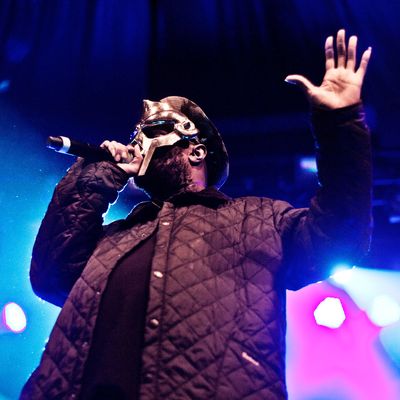
Frustration has always been essential to the MF Doom experience. Born Daniel Dumile, Long Island–raised rapper created his comic-book alter ego in the wake of losses so harrowing as they verged on the cartoonish. To hear Ta-Nehisi Coates’s 2009 profile tell the origin story, it was 1993 when Dumile’s younger brother, Dingilizwe, was killed by a car as he tried to cross an expressway; a week later, the release for Black Bastards, the sophomore album from KMD, the group the Dumile brothers were members of, was halted by its record company over concerns about the album cover’s caricature of a lynching. Years of homelessness and exile followed before Dumile returned to rap, his face shielded in a metallic mask. Like the A-list Marvel supervillain whose name he appropriated, Doom, though disfigured by catastrophic defeat, had survived and was prepared to avenge himself upon the world.
Vengeance, for the most part, took the form of rapping wittily and well, making frequent lyrical references to nerd-culture staples of the ’80s and ’90s, producing his own instrumentals, and above all, generating vast amounts of material: Years before Gucci Mane flooded his local market with mixtapes there was Doom, a new Atlanta resident, uncorking torrents worth of albums, loosies, mixtapes, instrumental mixtapes, collaborative tapes with other rappers and producers, and more. Taken together, the output made him a legend on the underground circuit in an era when major-label rap was mired in a particularly leaden form of materialism. Obsessed with marginality and arcana, Doom’s fan base soon became a distinct branch of the geek- and indie-rap cultures that had spawned Doom’s music. A stubborn relic of an era less obsessed with money and more obsessed with lyrical brilliance, Doom was never going to cross over into the spotlight. Notoriety among an insular set of aficionados was more than enough, though of course when Coates, commissioned by The New Yorker, came calling on his fellow black nerd, he didn’t say no, and even allowed the journalist to peep at his rhyme books.
The artist’s production has slowed considerably since 2009, though. Between visa troubles that prevented him from returning to the U.S. after an overseas tour and the sheer exhaustion to which even the most prolific creators are prone, there hasn’t been as much time or energy for new work. In the past seven years, there’ve been two collaborative albums (with fellow underground rappers Jneiro Jarel and Bishop Nehru, respectively) and little else. So there was great rejoicing among the still-faithful fan base when Adult Swim announced in August that Doom would be partnering with the network to release a fresh Doom track every week for 15 weeks under the rubric of The Missing Notebook Rhymes. Speculation abounded as to whether the new tracks amounted to a new album. Optimists even dared to believe that each track would come from a different new album. A preposterous assumption, but in the case of Doom, an artist renowned for being unlikely, anything seemed possible.
Seven weeks in, the results are decidedly mixed. Even if one counts the material released as fresh, at least some of it is certainly not new. “Notebook 06,” this week’s release, is a barely remixed version of “Pause Tape” from 2013’s JJ DOOM joint album; “Notebook 05” has been swirling around online for years on compilations under the name of “No Refunds”; “Notebook 03” sounds suspiciously like an outtake from 2005’s DangerDoom joint album; the verse from “Notebook 02,” though now layered over a sweet Alchemist beat, has been extant since 2012; “Negus,” the original entry, is actually a Sean Price song featuring Doom included on Imperius Rex, the posthumous album from Price released this year. Things like this are, if nothing else, a useful reminder that frustration has always been as essential to the MF Doom fan experience as it has been to the artist itself. Doom’s passing off old material as new harks back to the infamous concerts where, mimicking the comic book Doom’s use of robot clones, he would hire impersonators to perform in his stead. It’s amusing to hear on “No Refunds” — sorry, “Notebook 05” — “I sell them bums a scrap verse that’s so-so, nice / You get what you pays for, raps for the low-low price”; as if to signal that Adult Swim, a cool company renowned for budgets that could barely purchase the contents of a broom closet, having offered the artist scrap-metal prices, were being fobbed off with slag in due course.
To be fair, it’s not all tired work: “True Lightyears,” featuring the similarly reclusive, silent, U.K.-based expatriate, and virtuoso lyricist Jay Electronica, goes hard over a high flute line; and “Notebook 04,” with lines about Trump, how “the forces of evil keep winning,” and announcement of Doom’s 25th anniversary (KMD’s first album dropped in 1991, 26 years ago), sounds both potent and recent. But even so, it’s hard for Doom loyalists to receive so little in return for their faith. Fortunately, mainstream hip-hop is in far better shape than 10 or 15 years ago, when Doom and the need for him was at its peak. References to animé abound in the work of countless younger rappers, Lil Uzi Vert most prominent among them; West Coast artists, Kendrick Lamar in particular, have resurrected the old-school priority of lyricism over materialism, proving that it’s still possible to sell out stadiums without selling out. Though the mystique of Doom endures, whether Doom himself remains necessary is, like the final eight weeks of The Missing Notebook Rhymes, an open question.

